UBUD, BALI, INDONESIA
2016-06-25, 13:00, JASON
BUDGET , STAY: JATI HOMESTAY
For fans of South Pacific the musical, the week leading up pretty much entailed me singing "Bali Haiiiiiiiiii may calll youuu." A good song to add to your repertoire of "place song musicals." Bali, Oklahoma, etc. Also great if you want to get on everyone's nerves and have everyone eventually join in.
Was this an Eat, Pray, Love jourey? Yes. On the tourist WikiVoyage page there even was a sidebox commentary about the Eat, Pray, Love phenomenon in which large groups of (mostly) white women in their mid thirties flock to Bali to find some spiritual awakening. I primarily went to do yoga with Jane, our roommate, who joined in on the Bali Haiiiiii fun, and given yoga's place in many womens' lives, you could say we were there to do a little EPL. Maybe just a lot of eating, actually..
We arrived in about 19:00 after having drunk a few cans of Bintang beer, an Indonesian local brand, on the inbound Garuda Indonesia flight. Thorin and I aren't used to traveling on a name brand airline since most of the cheap flights are budget, meaning there's no food, service, or leg room at the cheapest price (Upgrade and pick your seat for only $29.90!). Oddly enough, the flight to Bali that was the cheapest for this weekend was on Garuda, which was actually bumped to five star service recently, so we were blessed with a meal on a two hour flight. For the shameless passengers, you could also get a can of Bintang beer complementary with your meal. In place of finding spiritual enlightenment, we found our BAC increasing. Upon arriving, we were meant to get picked up by our homestay (so posh) and drive into Ubud from Denpasar, which is an hour plus journey depending on traffic. Jane had her name announced on the loudspeaker since we couldn't find our driver holding the sign with Jane's name, among a sea of other touters and drivers who were picking up their own tourists. No problem, they found us in the end and we were on our way.
We had a few issues with checkin, but I shant dwell too much on that. They had overbooked so they stuck us in the homestay nearby. A bit disappointed, we asked if there were areas in which we could grab some food, and had our first meal. I decided I'm going to start keeping a better food diary so have been taking pictures of all the varieties of dishes we've eaten. I'll put it on Insta I guess. Follow our new Food Instagram! First up, Gado Gado as well as Tempe Pepe, two local dishes. As an overall, Balinese food tends to be light in oil and contains very fresh ingredients. I imagine it has something to do with the Hindu influence. Comparing the food to Jakarta, it's a totally different style of cooking, even though they share the same nationality. Many of the dishes will come with vegetables as well that all taste fresh. In fact, it reminded me a bit about the aboriginal food we had in Taiwan prior. Thorin ordered a pot of Balinese coffee too, which resembled that of Turkish coffee in terms of the granular production. After that, we went back to our homestay to sleep since it'd been a long day. After all, we spent most of it drinking.
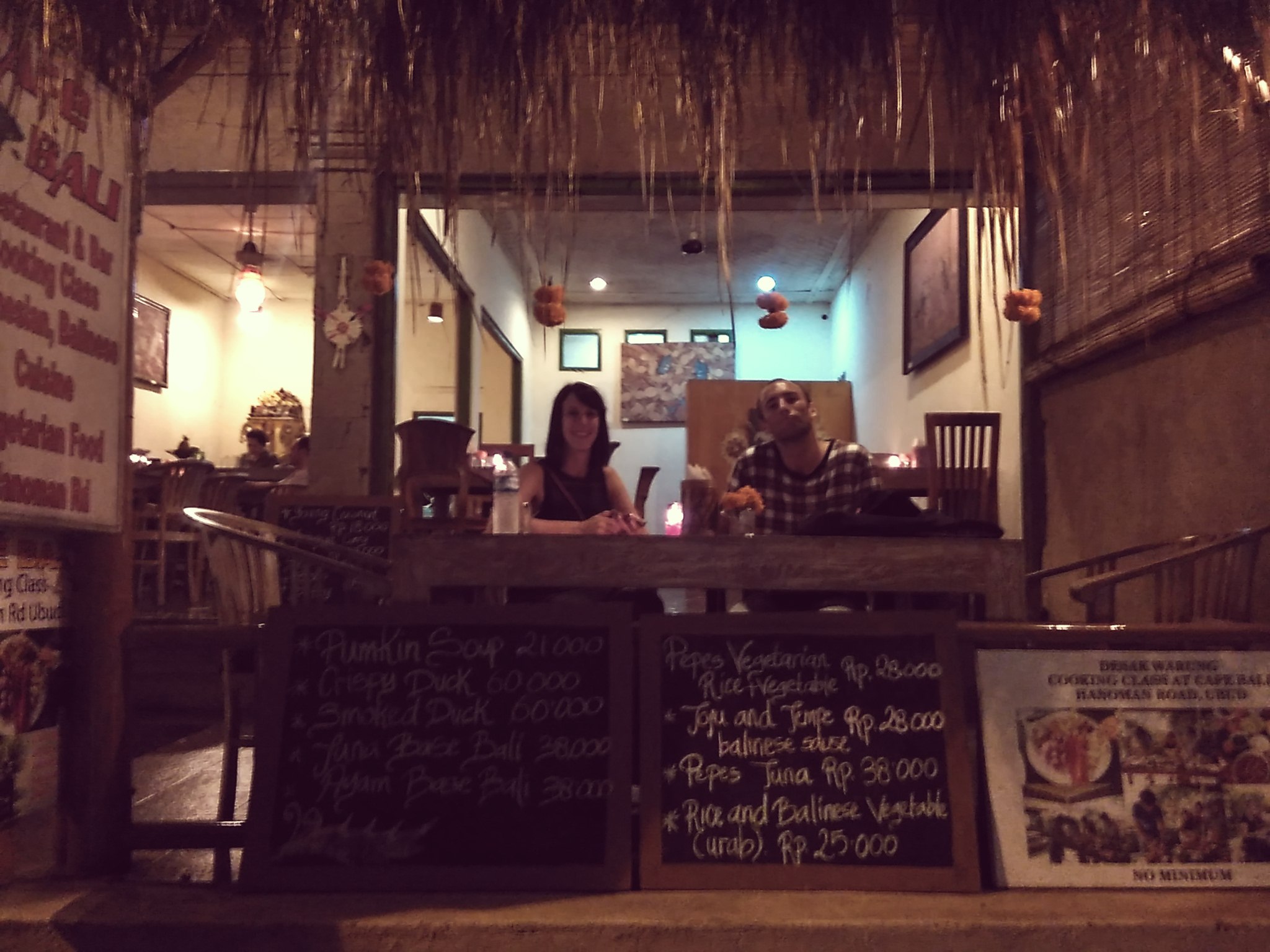
Bali is a Hindu island in the country of Indonesia, a majority Muslim country. The island is fractured into geographical regions that are known for certain things: Central Bali (Ubud, where we went) which is a cultural hub of the area, South Bali (Seminyak, Denpasar, Kuta) which is often visited for the party scene, and "everything else." "Everything else" includes the northern beachy shores and the eastern coastal villages. As a whole, the Ubud area is overrun with tourists, passing a foreign face everywhere you go. You drive up to the rice fields, foreigner. You go to the temple, foreigner. I'm not sure what caused the phenomenon of Bali as a top tourist destination -- perhaps, the Eat, Pray, Love ordeal. However, it seems to have been perpetuated and flourished by by word-of-mouth between travelers. There were many western tourists as well as the upcoming eastern varieties, including South Korean and Chinese. This is great for the local economy, no doubt, but I get apprehensive about cities that are too washed out. However, much in the same way Bangkok proved me wrong about the washing out of local culture, so Bali did the same. Despite mass tourism, there was still a strong local identity, and it's very much tied to the local Hindu religion.
The famous sites to see in the Ubud area are temples, and these are carved out with an intricate and humble style. The best part about Balinese architecture is that these temples are incorporated very well into the lifestyle of the local Balinese. If anything, I should say that the recent tourist culture has incorporated well into the traditional Bali lifestyle. That morning, we decided to go to Goa Gajah, the Elephant Cave just about 4 or 5 km away from the Ubud city center. He told us that each family has their own temple that they worship at, and there are temples also governing townships. Pretty much, there are loads of temples everywhere. The cool part is that while walking through the central area, you still see many of these temples standing and people continue to live in them. Some have turned their houses into tourist shops or spas, but some still maintain the original construction, with repairs here or there. These houses are all living relics of history, and when you walk through the city you find yourself snaking through these pathways that are constructed around these houses. So, despite the tourists crowding the streets and market area, you're reminded that you're in Bali with these cultural structures that have somehow adapted to the changing scenery. Another thing is, much of the layout is very open and natural. Living in Singapore, you get really good at picking out air conditioned spots and relishing in the first touch of those cold air droplets on your skin after having been outside. In contrast, very few places we went to in Ubud had air conditioning, and have relied on natural shading to remain cool. It gives you a feeling you're constantly in the jungle, surrounded by nature. Even most of the restaurants were open air. It's not so surprising that the cultural openness (on the surface) the Balinese generally display is also emulated in their lifestyle and architecture, maybe with influence from their religion.
But, those are just the house temples, peppered throughout your stroll along the Ubud center area. Their formal temples are also something else. At the entrance, they will wrap you into a sarong and then send you on your way to explore. The details etched into the temple walls are unbelievable. At Goa Gajah, you can walk around the temple and enter the main "Demon's Mouth" gate and see some Hindu gods inside. Likewise, the surrounding jungle offers some small trails that you can hike to see small shrines in the surrounding area, with random rock carvings along the way. You can see why people imagine this place to be mystical. Someone needs to write a sociology dissertation on the fascination of the outsider with Hinduism, as seen by mass tourism to India and Bali. I'm calling it, it's going to win an Ig Nobel Prize.





As Bali is also known for rice fields spanning acres, there's nothing short of the view. After Goa Gajah, because we were too cheap to pay for a taxi back to central Ubud, we decided to go for a 4-5km walk back. A majority of the time was spent trekking along the paved roads while looking at the small shops lining the road. All of these also seem to have been opened by families, and are at various stages of existence, from old-temple to cement construction skeleton. While walking, a field appeared to our left -- maybe we appeared to its right -- and we decided to take a small pedestrianized path in. It had been a lovely, sunny (if not too sunny, but who can complain) day in Bali, and so the sun was hitting the field perfectly. Walking into the field a little bit and bypassing a local's house, we took some pictures.

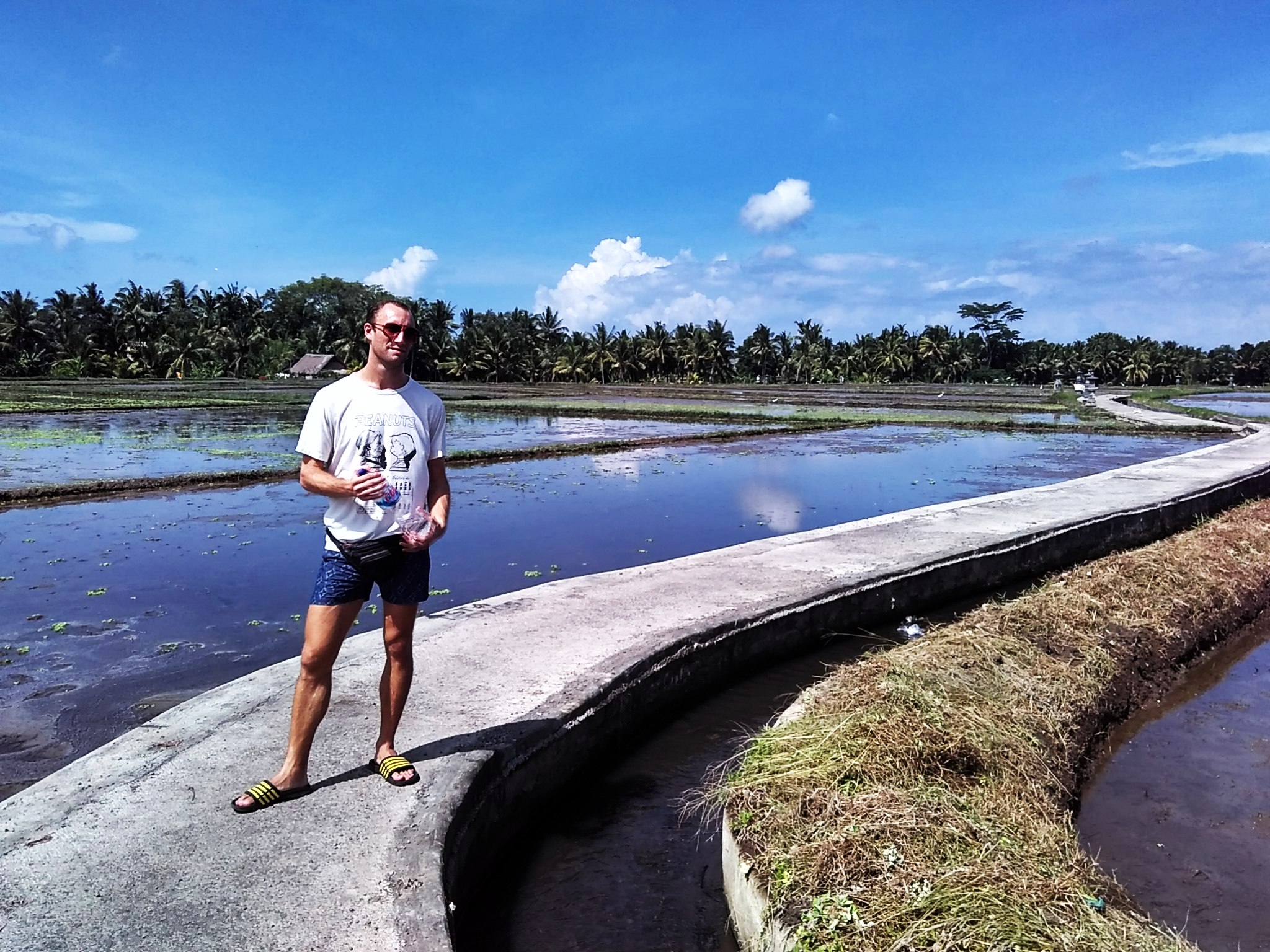
Another famous dish in Ubud is served by Bebek Bengil, or, the Dirty Duck. This is considered a splurge restaurant by Indonesian standards and costs roughly about 14-20 SGD per person to eat. If you're earning money in USD or GBP (although, at the time of writing this, the British Exit vote has just passed and so GBP may not be as strong), then it's quite worth a try. The portions are massive and the food is delicious. It's cooked in that Balinese fashion, with fresh ingredients and an organic taste. The duck is very flavorful, too, if you're a fan of fowl. It's funny, the architecture here. On the outside you would think that Bebek Bengil was a small restaurant, seating about 100 people or so, but when you walk into it the place expands out to the back by a lot. And not just to anywhere, to another rice field. Soooooo Baliiii guysssssss. It's not just the restaurants, the same with our homestay. You walk into some alley and then it ends up weaving around a bunch of houses until you get to your destination. Even though you have only walked about 100 meters in from the main road, it feels like you're back in the countryside, surrounded by local Balinese and either rice fields or jungle.

And, what kind of a night out is it in Bali if it doesn't involve some cheap drinking at a trashy bar? Jane, Thorin and I headed to a bar called Nomad and decided to capitalize on their happy hour: 125,000 Indonesian Rupiah (About 2.5 Singaporean dollars per bottle) for a bucket of Bali Hai Beer, the other local brand ("Baliiii Haiiiiiiiiiiiii may call youuuuuuu"). We chugged it down, I had some local Ajak style Balinese alcoholic drink, then we went over to BreadLife to have some starch. I bought a bun that was the size of my face, called a Hokkaido Bun. Actually, this bun was such a hit that the night before we left Bali, we each bought one to-go so that we would have something to eat on the way to the airport the following morning.

Sunday in Bali is a holy day , and we had no idea until we went to Tirta Empul, the water temple, outside of the city center. We negotiated with a taxi driver on the price to Tirta Empul. He charged us 300,000 IDR round trip (30 SGD) for the temple, and we were able to negotiate it down to 175,000. On the way up, he began sharing stories about Indonesian corruption in the police as well as in society; about how the Indonesian people function and work. Although we took it as a singular account of the Indonesian experience, it was particularly enlightening since he conveyed a deep passion to want to help Indonesian people, and had a great understanding as to the general Indonesian struggle. As Indonesia goes, being the most populous state in the Southeast Asian region, they have relied on their labor as a main export to bring remittance money back to the country. If you go around Hong Kong or Singapore, many domestic workers will be Indonesian. Likewise, in Muslim countries in the Middle East, they will also depend on international labor to supplement their economy. However, as labor is exported internationally, it's difficult for the Indonesian government to monitor and control human rights abuses for live-in helpers. So, these migrants -- largely women, if not exclusively -- are relegated to the task of menial house labor and abuse. Of course, it's a difficult stand for the foreigner to comment on because it's easy for us to put down the practice, but it is still a living, and the remittance money has helped some Indonesian families stay afloat. It's about the policies in place to support workers abroad as the world internationalizes. Our driver expressed strong disinterest in the practice, and about needing to protect Indonesians abroad. He was a staunch supporter of not selling out his faith for money (when talking about people that wanted to open their home temples up for a small fee for a tourist attraction). He talked about why there's no progress in Indonesia due to the corruption in the police and the government, how everyone wants power without responsibility. He talked about the uglier side to tourism. Everyone wants a slice of culture -- The Balinese to protect their own, and the tourists a piece of theirs. I started to feel a little guilty that we had bargained down his initial offer of 300,000. However, he's a good business man. He was smart. He's in the deal of negotiation, and knows what he was getting into when he took us cheapskates into his car. I asked him what his rate was to the airport from Ubud, and he said coyly, "You offer first, if I give you a price you will just offer 50% of it." To which I had to applaud. 300,000 IDR it is, then, to the airport. The experience driving up with him was worth more than anything.
Tirta Empul on a Sunday was a breath of fresh air. Many people will wait to enter the temple baths and cleanse themselves, and they let the tourists in to watch this experience. Crowds gather at the pool entrance, and as soon as the masses enter the water is displaced, all while cleansing themselves at the open taps in preparation for worship. The Balinese will then gather at the shrines to pray. We wander around the temple grounds and observe passively. A shrine here or there, the hot-spring vent that is surrounded by lavish limestone structures, watching the Balinese practice their faith. Living, breathing culture, hundreds of years in practice, in front of our own eyes.


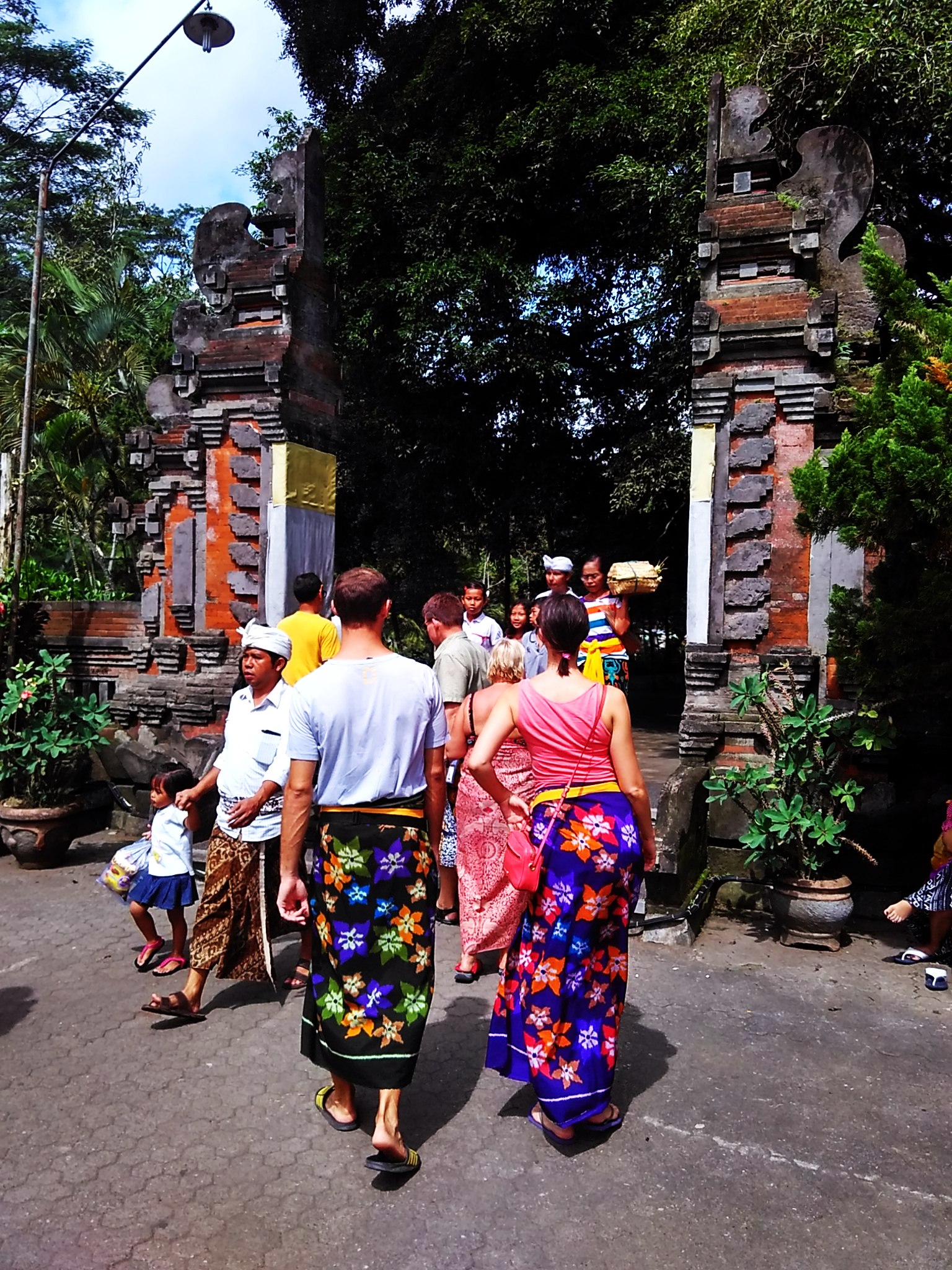
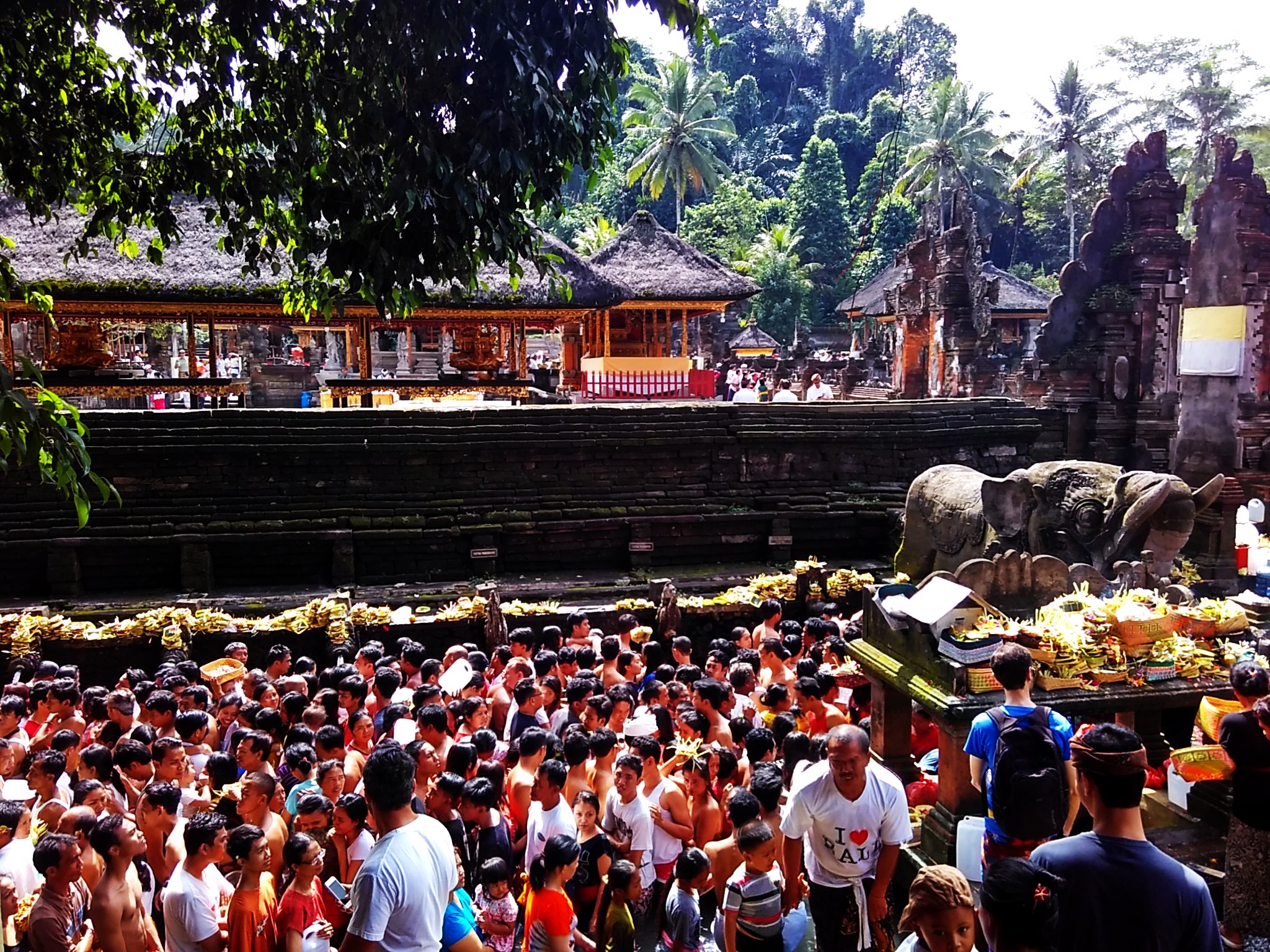

The dress of the men is interesting in these temples. They wear a headpiece that looks tribal, a piece of cloth wrapped around the temple with the top of the head exposed. On the side, a small triangular shape will stick out. The shirt is a loose, cool garment and there is a nicely wrapped sarong. It's actually kind of sexy. Does that count as exploitation of people in the developing world?

Just as interesting to the conversation on the way up and the temple is the scenery. You pass by more rice fields, a beautiful, staggered and stepped plateaus filled with water and the seasonal rice harvest. Somewhere in there, the farmers are plowing their field with their tractor machinery. Seeing this through the car is a shame, if you were to take a walk through the area it would have been a better way to savor the environment. Living, breathing culture.


For tourists, there are popular things to do in Ubud, as there are in any tourist destination. We found solace in the yoga and the food. Thorin joined Jane and me in a yoga session at the Yoga Barn on the Sunday, and Jane and I went for a morning class on the Saturday. The morning crowd is nice since most of them are there just to do yoga, but the afternoon crowd on a Sunday was, er, rather Burning Man-ish. Since it was United Nations world yoga day, there were many hippies sat together in kum-ba-ya circles, Janis Joplin lookalikes, and shirtless men sitting and meditating around the foyer. Also, since there is a restaurant nested in the yoga barn -- again, reminding us of that Balinese "looks small on the outside but expands into the back" look -- there are circles of white folks sitting around in their various LuluLemon yoga pants (women) and shirtless 'attire' (men) chatting about god knows what. Bleuch. OK, that was judgy. I mean to say it's not for me. If I wanted to go to Glasto I just would've gone there, not at the yoga barn. However, I can say the classes were all very well done, and at a reasonable price for that.
The other popular thing to do is eat some Babi Guling, a kind of a Balinese version of the Filipino lechón, yummy cooked pig. And, the thing is the Babi Guling all comes from one pig and so they only open from noon and siesta in the mid afternoon. We went to Ibu Oka, a well-known Babi Guling place, and tried some of their pig. Probably some of the most succulent pork I've had, and they even add in a bit of pork gristle and crispy pig skin. I fully support this.
For the rest of the day, Thorin and I walked around Ubud market and just strolled around the street, relaxing. Since we're usually quick in traveling, we decided to just take it easy and walk around the streets of Ubud to take it all in. We stopped in another homestay and had some of their nasi lemak and cap cay (pronounced chop chai), a vegetable soup. They really know how to do food well here, as is the case with most of Southeast Asia. And, the homestay owner was nice and had a conversation with us about where we were from. He had lived in the homestay his whole life and just decided to serve food out of his own kitchen. For a tip in travelers going to Southeast Asia: the best food is found on the street, not in a restaurant. The restaurant, I'm convinced, is a western concept. In the U.S. and U.K., you go to an expensive restaurant and pay for good food. Here in the developing world, you go to a shack on the side and have the best food you've ever tasted. One love, Southeast Asia, to your cuisine.
After wandering the market, we go to Puri Saren Agung, a palace of kings just right across the Ubud Market. Apparently, there are still descendants from the kings that live there, but they didn't show up. I don't think they got the memo that I was there to experience their culture? Not sure, but really rude of them. What we did run into though was a bunch of other tourists and a dog scratching and licking its gonads, which I think was a close second.
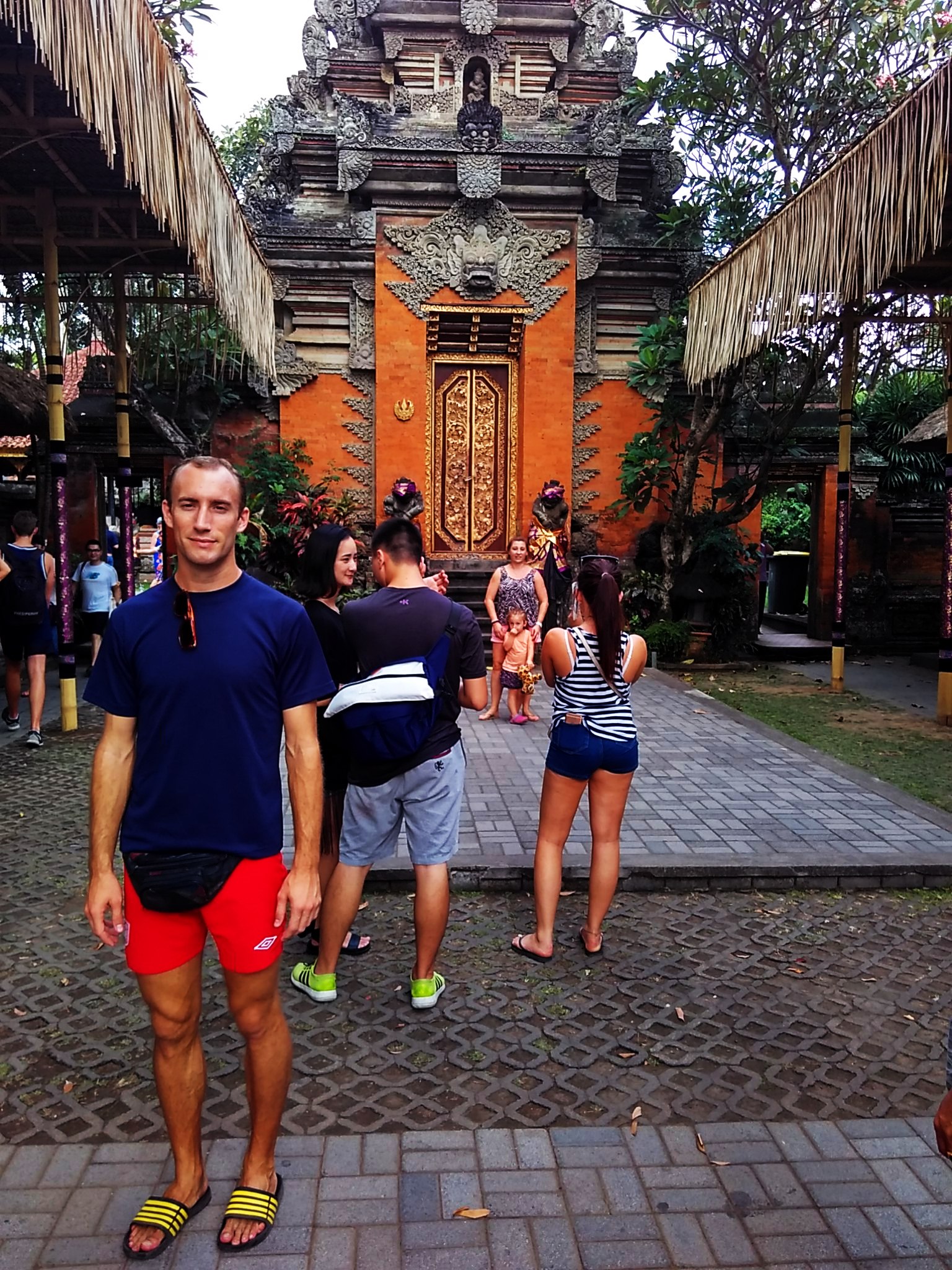

What impressed me most about Bali wasn't necessarily that it was so easy for the tourist. You could walk around everywhere and the place is affordable. What did impress me though was the vastness of the island itself. Ubud was just a small slice of Balinese culture, and despite the tourist culture, they have still maintained a Balinese way of life. I loved how the houses had history to them, and while walking down the street you could see that. They hadn't built modern homes, or packed into high rise condos, they have continued to live in the houses they have lived in for centuries. But, there's a lot more out there. The north of the island looks stunning, and they have temples built into lakes and next to the beach. The east looks stunning, too. What I had done is conflated this overrun tourism culture of Bali and ascribed it to the culture. Now, all I want to do is go back and break down that image. Bali HAIIIII MAY CALL YOUUUUU. Any night, any day.